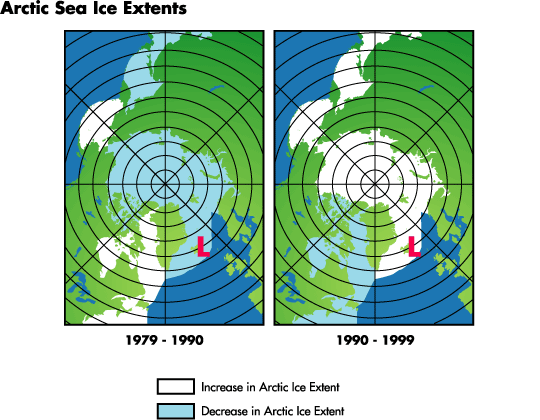


Largely natural “ups and downs” in a weather system centered near Iceland have contributed to regional variations and an overall decrease in Arctic sea ice cover over the last twenty years, according to new NASA research.
As this semi-permanent low-pressure system intensifies and weakens, it affects the amount of air (generally warm) being brought into the Arctic to the east of the low and the amount of air (generally cold) being swept out of the Arctic to the west. These changes in turn affect the amount of ice cover in the respective regions, adding to the effects of climate warming.
Claire L. Parkinson of NASA’s Goddard Space Flight Center in Greenbelt, Md., highlights the changes in Arctic sea ice and their possible connection to the Icelandic low-pressure system in a paper appearing in the most recent issue of Polar Geography.
Parkinson plotted the extent of sea ice using satellite passive-microwave data from 1979 through 1999. Data were analyzed from the Nimbus 7 satellite and three satellites of the Defense Meteorological Satellite Program (DMSP). Results confirm an overall decline in Arctic ice extent that has been connected with climate warming, but also show regional differences that suggest there are other influences.
The “Icelandic Low” is a key to bringing a greater or lesser amount of warm air into the Arctic depending on the intensity of the system, and is part of a larger weather pattern called the North Atlantic Oscillation (NAO). NAO is the name for changes in the difference of air pressure between the semi-permanent low-pressure system centered near Iceland (the Icelandic Low) and a semi-permanent high-pressure system centered near the Azores Islands (better known as the Bermuda-Azores High).
On average, both of these systems are present all year; however, both are strongest in winter. When both the high and the low intensify and fluctuate in pressure relative to one another, they change the circulation of cold and warm air in the region.
When the Icelandic Low is strong, it forces cold Arctic air southward to the area west of Iceland and Greenland, setting the stage for increasing sea ice cover in Baffin Bay, the Labrador Sea, Hudson Bay and the Gulf of St. Lawrence. At the same time, to the east, warm air that is swept northward reduces ice extent. This warmer air contributes to the reduced ice extents east and north of Greenland, and the reduced extent of ice in the entire Arctic overall. “When the Icelandic Low is weak, it will still bring warm air northward to the east of Iceland, but not as much as when the Icelandic Low is strong,” Parkinson said.
For more information, visit: Icelandic Weather System Helps Decipher Changes in the Arctic Ice Puzzle
For information about other effects of the North Atlantic Oscillation, read: Searching for Atlantic Rhythms: Winter Weather and the North Atlantic Oscillation
Image courtesy Claire Parkinson and Nick Digirolamo, NASA Goddard Space Flight Center